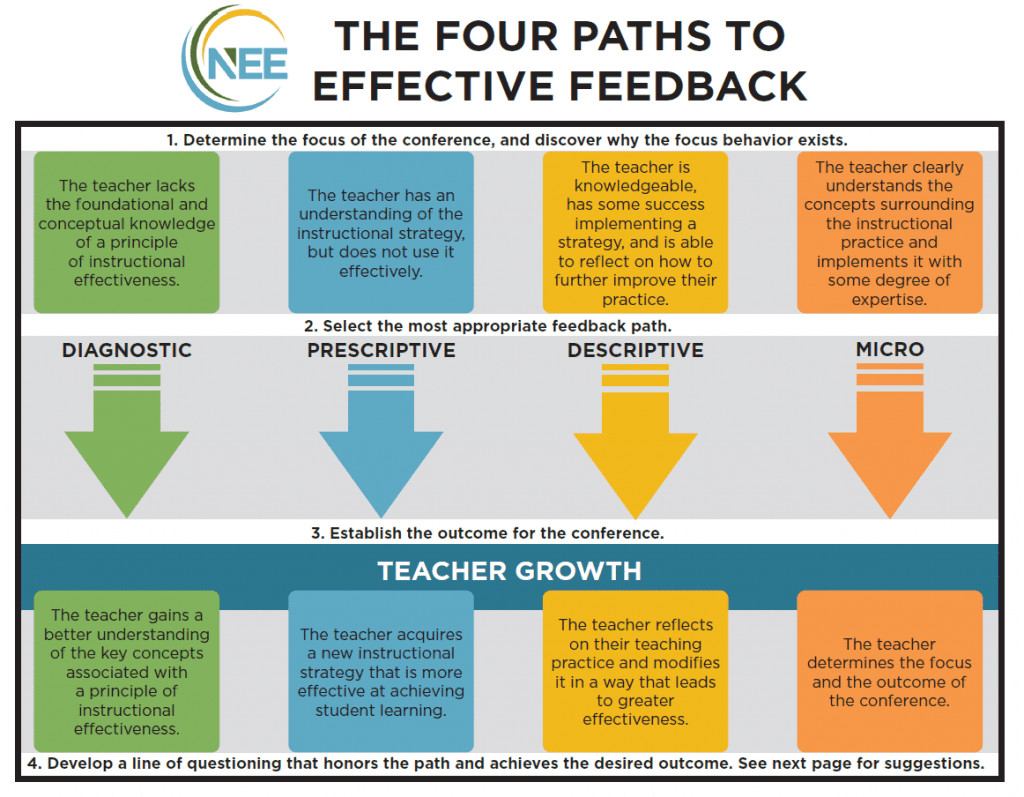How School Leaders Can Use Micro Feedback to Listen and Learn
One of the most important jobs assigned to a principal is the evaluation of teachers. A critical question all principals should ask themselves is: “Do I judge teachers, or do I evaluate teachers?” Before answering this question, consider the difference between the two. The act of judging can be subjective while the act of evaluation produces an opinion that is based on carefully observed facts and contemplative thought given back to the teacher. A principal that rushes to the judgment of a person’s teaching without slowing down to carefully evaluate will soon lose the trust of the teacher and credibility as an evaluator.
Judgments have a sense of conclusive finality to them while evaluation signals the invitation to explore other instructional opportunities. Evaluation encourages conversation and a sense of exploration; it is not a verdict.
The Network for Educator Effectiveness offers principals four paths to effective feedback that are based on the individual needs of the teacher: diagnostic, prescriptive, descriptive, and micro feedback.
While all four of the paths can result in a conference based on evaluation, the micro feedback path lives in the world of open reflection and consideration. Micro feedback is often used with strong, experienced teachers who demonstrate high levels of success in the classroom. It is free of judgment, allowing the teacher to set the focus and direction of the feedback conversation while the principal plays the role of listener, coach, and cheerleader. It is used to explore the teacher’s thinking, decision-making, and motivation.
So, is this micro path reserved only for our most formidable and experienced teachers? Are they the only teachers that would benefit from this micro feedback path? After serious thought, I have a few situations where I believe other teachers would benefit from a walk down the micro feedback path.
I would apply the micro feedback path if:
I had a teacher new to my school or new to the profession.
How can you evaluate someone with whom you have had very limited interaction and have watched them teach on a very limited scale? Have you collected enough information about their teaching to provide an evaluation or simply a quick judgment? Maybe the first feedback conversations could be used to find out what this new teacher is passionate about, what is their teaching philosophy, and what do they believe are their strengths and struggles. All of these facts will serve to influence future evaluations.
I had used the diagnostic or prescriptive feedback paths several consecutive times with a teacher.
The diagnostic and prescriptive paths are both necessary and effective in providing feedback. They build a teacher’s foundational knowledge and provide strategies and skills for the teacher. They also put the principal in the driver’s seat to determine the focus of the post-observation conference and establish the desired outcome for the evaluation conversation. It is tempting to continue using these paths with a teacher that is beginning their teaching career and has so much to learn. They are also the paths of choice when working with a teacher that is struggling. If you have used these paths repeatedly with a teacher, maybe it’s time to step back and ask the teacher how they are feeling about their instructional progress. Only using these two paths may make the teacher feel defeated and stifled in their ability to progress. Could the use of the micro path give this teacher some self-confidence and remind them why they chose this profession? Maybe using this path periodically will help them feel less judged and more motivated to continue to grow and improve their practice.
I felt that as an evaluator I was becoming quick to serve judgment.
Has your principal plate become so full that you are no longer evaluating but offering judgments? It is much easier and faster to come to a quick judgment than a thoughtful evaluation. Utilizing the micro path will force you to slow down and listen to the teacher. It causes you to think about the entirety of their teaching, not just about the details you have decided to judge. It may help you understand the strengths and weaknesses of their teaching from their viewpoint and keep you from making false assumptions. Anytime you start guessing, you are judging.
I saw no improvement in a teacher’s performance after several conferences.
Something is not right. Most teachers want to improve, and usually you can see some level of improvement from the efforts of your post-observation conference. But if improvement is not occurring, it leaves you scratching your head and wondering if they aren’t able to recognize the issues with their teaching. Did you not communicate clearly, or maybe they didn’t understand how to make the changes you were requesting? Reiterating the same conference over and over is not going to produce the desired outcome. Why not change it up to a micro feedback conference and give the teacher a chance to explain what they believe are the issues in question. Let them talk about their teaching and listen for clues to the lack of progress. Beating the same dead horse isn’t going to win any races.
I wanted to take the temperature of the faculty.
Understanding the stress level of teachers and being aware of their opinions about the current state of affairs at school are valuable pieces of information for a principal to ascertain. Discovering what’s on the minds of teachers is crucial to the management of your school. There are many ways to gather this information, but one sure-fire method is to utilize the micro feedback path to explore the mindset of teachers. You may not need to do this with every teacher. Giving a few chosen candidates the opportunity to share their insights will give you a sampling of the mindset and perceptions of the faculty and staff. Assessing the discernment and sensitivity of these professionals will go a long way in helping you to meet their needs and the needs of the building.
The knowledgeable, skilled, expert teacher.
I list these professionals again in this list with the hope that you will consider them to be the avenue that grows you as an instructional leader. I know without a doubt that these amazing people taught me more about great teaching than I ever bestowed upon them. They are more animated and passionate than any textbook, and they can light your motivational fire if you sincerely listen with a learning ear. Don’t miss the opportunity to learn from these brilliant professionals.
Let the micro path work for you and your teachers. Keep your mind open to the circumstances that might benefit from a little less talk from you and a little more listening.
We have two ears and one tongue so that we would listen more and talk less.
–Diogenes
Cheri Patterson is a trainer and field support representative for the Network for Educator Effectiveness. She joined NEE in 2013 after an extensive career in K-12 education as a teacher, principal, and associate superintendent.
The Network for Educator Effectiveness (NEE) is a simple yet powerful comprehensive system for educator evaluation that helps educators grow, students learn, and schools improve. Developed by preK-12 practitioners and experts at the University of Missouri, NEE brings together classroom observation, student feedback, teacher curriculum planning, and professional development as measures of effectiveness in a secure online portal designed to promote educator growth and development.




